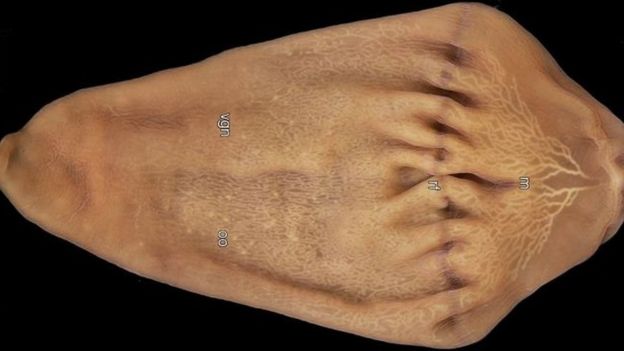Origin of mystery deep-sea mushroom revealed
 Image copyright Hugh MacIntosh Image caption Dendrogramma was named for the branching channels visible in its body mass Australian scientists have used genetic material to pinpoint the origin of the deep-sea mushroom, an unusual gelatinous creature first dredged up near Tasmania in 1986. The organisms have a cylindrical stalk capped by a flat, semi-transparent disc that houses visible channels branching outwards. These channels, which resemble tree-li..>> view original
Image copyright Hugh MacIntosh Image caption Dendrogramma was named for the branching channels visible in its body mass Australian scientists have used genetic material to pinpoint the origin of the deep-sea mushroom, an unusual gelatinous creature first dredged up near Tasmania in 1986. The organisms have a cylindrical stalk capped by a flat, semi-transparent disc that houses visible channels branching outwards. These channels, which resemble tree-li..>> view originalExperts claim extraterrestrials 'die young' on other planets
Astronomers have found a plethora of planets around nearby stars.And it appears that Earth-sized planets in habitable zones are probably common.So, with tens or even hundreds of billions of potentially habitable planets within our galaxy, the question becomes: are we alone?Scroll down for videos Astronomers have found a plethora of planets around nearby stars. And it appears that Earth-sized planets in habitable zones are probably common. So, with tens or even hundreds of billions of potentiall..>> view originalGreens pledge new environmental protection laws and independent watchdog
The Greens want to create a tougher independent environmental watchdog and a new set of environment laws for Australia. They said the current system is failing because it is too easily exploited by powerful miners and developers. The Greens leader, Richard Di Natale, said the Greens will push in the next parliament to establish an independent statutory national environment protection authority (NEPA), modelled on the EPA in the United States. Related: Campaign catchup: Labor digs in on childc..>> view originalAspendale climate research lab to lose 32 staff in CSIRO restructure
Workers at the CSIRO Marine and Atmospheric Research Centre in Aspendale meeting with Federal member for Isaacs Mark Dreyfus about job cuts to the CSIRO. Picture: Valeriu CampanANGRY climate change scientists have taken to the streets after at least 32 jobs at the Aspendale CSIRO lab were axed, in a move insiders fear could spell the end of the world-leading research centre.CSIRO Community and Public Sector Union organiser Dr Michael Borgas said “essentially that decision has already been made”...>> view originalBizarre photo of a fish in a jellyfish
IF FISH CAN be said to have facial expressions, then the look on this little one's face would certainly appear to be saying something along the lines of: "oh dear, how did I get here?" Or, as one commenter on the social media platform Reddit (where this image was originally shared) suggested: "Honey, you probably won't believe this, but I'm stuck in a jellyfish." No, this isn't a strange new species. (Image: Tim Samuel). The bizarre occurence was captured in the waters off Byron Bay, New South..>> view originalEast coast storm: Scientists want erosion monitoring to deal with impacts of climate change
East coast storm: Scientists want erosion monitoring to deal with impacts of climate change Posted June 06, 2016 19:38:28 There are renewed calls for national monitoring of Australian beaches in the wake of severe storms which washed away homes and other waterside properties along the east coast.The Water Research Laboratory at the University of New South Wales, led by Professor Ian Turner, has been monitoring Narrabeen and Collaroy beaches, two of the hardest hit in ..>> view originalGreat Barrier Reef coral bleached and covered in slime, dramatic new images show
Great Barrier Reef coral bleached and covered in slime, dramatic new images show Updated June 07, 2016 13:03:18 Dead coral skeletons covered in algae have replaced the once-vibrant coral in parts of the northern Great Barrier Reef hit by severe bleaching, new images reveal.The photographs and video, released by WWF-Australia, were taken at Lizard Island off far north Queensland, one of the first areas to bleach.Last week, the Great Barrier Reef Marine Park Authority sai..>> view originalMystery over first Australians finally solved
Skeleton of an Aboriginal man dug up in Lake Mungo in 1974 has been confirmed to be Aboriginal. Picture: Supplied.FRESH research has refuted previous scientific claims that ancient Aboriginals were not the first people in Australia. Scientists from Griffith University’s Research Centre for Human Evolution (RCHE) have found evidence that demonstrates Aboriginal people were indeed the first to inhabit the continent, disputing an earlier landmark study that claimed to recover DNA sequences from the..>> view originalEfforts to save koalas have failed: Queensland
The Queensland government admits efforts to save koalas are failing and will turn to scientists to salvage what's left of once healthy populations. A dire scientific report, commissioned by the government, has found koalas are effectively extinct in parts of the state's southeast corner. The government hopes $12 million in next Tuesday's budget can arrest the catastrophic population decline recorded over the past 20 years. The South East Queensland Koala Population Modelling Study found number..>> view originalBellies full of microplastic rob baby fish of their basic instincts
Larval European perch that has ingested microplastic particles (light-colored spheres on bottom side). Photo by Oona Lönnstedt When exposed to microplastics, baby fish stop eating natural food and prefer consuming the pollutant, according to a report from ecologists at Uppsala University in Sweden. The dietary switch derails the basic instincts of the fish, the researchers found, elevating the likelihood of being caught by predators. The findings may explain why populations of European perch (P..>> view original
Tuesday, June 7, 2016
Origin of mystery deep-sea mushroom revealed and other top stories.
Subscribe to:
Post Comments (Atom)
No comments:
Post a Comment